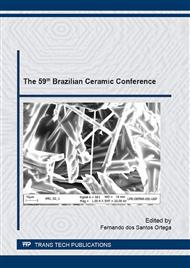p.165
p.171
p.176
p.181
p.187
p.195
p.200
p.206
p.212
Production of Single-Phase Hydroxyapatite Porous Bodies from Gypsum/Polystyrene
Abstract:
Porous bodies were produced using hydroxyapatite as a starting material, gypsum, high purity material, low cost and that can be molded into the desired shape. Also, beads of polystyrene polymer. The first step of this work was to produce porous gypsum blocks obtained by mixing gypsum, water and polystyrene. After drying, they were submerged in acetone solvent for solubilizing the polymer and pore formation. The porous hydroxyapatite was synthesized in a second stage, where the porous gypsum blocks were immersed in a solution of (NH4)2HPO4 0.5 mol L-1 to 100 ° C and pH 7.0-9.0 for 24 hours. From this method, it was possible to produce bodies single phase hydroxyapatite with a maximum porosity of 70 ± 3% and a compressive strength of 1.48 ± 0.17 MPa.
Info:
Periodical:
Pages:
187-192
Citation:
Online since:
November 2016
Keywords:
Price:
Сopyright:
© 2017 Trans Tech Publications Ltd. All Rights Reserved
Share:
Citation:


